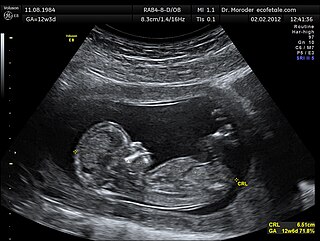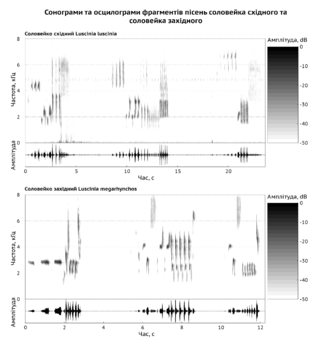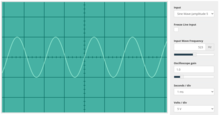
Acoustics is a branch of physics that deals with the study of mechanical waves in gases, liquids, and solids including topics such as vibration, sound, ultrasound and infrasound. A scientist who works in the field of acoustics is an acoustician while someone working in the field of acoustics technology may be called an acoustical engineer. The application of acoustics is present in almost all aspects of modern society with the most obvious being the audio and noise control industries.

Frequency is the number of occurrences of a repeating event per unit of time. It is also occasionally referred to as temporal frequency for clarity and to distinguish it from spatial frequency. Frequency is measured in hertz (Hz) which is equal to one event per second. Ordinary frequency is related to angular frequency by a scaling factor of 2π. The period is the interval of time between events, so the period is the reciprocal of the frequency.

The hertz is the unit of frequency in the International System of Units (SI), equivalent to one event per second. The hertz is an SI derived unit whose expression in terms of SI base units is s−1, meaning that one hertz is the reciprocal of one second. It is named after Heinrich Rudolf Hertz (1857–1894), the first person to provide conclusive proof of the existence of electromagnetic waves. Hertz are commonly expressed in multiples: kilohertz (kHz), megahertz (MHz), gigahertz (GHz), terahertz (THz).

Ultrasound is sound with frequencies greater than 20 kilohertz. This frequency is the approximate upper audible limit of human hearing in healthy young adults. The physical principles of acoustic waves apply to any frequency range, including ultrasound. Ultrasonic devices operate with frequencies from 20 kHz up to several gigahertz.

Pitch is a perceptual property of sounds that allows their ordering on a frequency-related scale, or more commonly, pitch is the quality that makes it possible to judge sounds as "higher" and "lower" in the sense associated with musical melodies. Pitch is a major auditory attribute of musical tones, along with duration, loudness, and timbre.

The cochlea is the part of the inner ear involved in hearing. It is a spiral-shaped cavity in the bony labyrinth, in humans making 2.75 turns around its axis, the modiolus. A core component of the cochlea is the Organ of Corti, the sensory organ of hearing, which is distributed along the partition separating the fluid chambers in the coiled tapered tube of the cochlea.

Infrasound, sometimes referred to as low frequency sound, describes sound waves with a frequency below the lower limit of human audibility. Hearing becomes gradually less sensitive as frequency decreases, so for humans to perceive infrasound, the sound pressure must be sufficiently high. The ear is the primary organ for sensing low sound, but at higher intensities it is possible to feel infrasound vibrations in various parts of the body.

A dog whistle is a type of whistle that emits sound in the ultrasonic range, which humans cannot hear but some other animals can, including dogs and domestic cats, and is used in their training. It was invented in 1876 by Francis Galton and is mentioned in his book Inquiries into Human Faculty and Its Development, in which he describes experiments to test the range of frequencies that could be heard by various animals, such as a house cat.

Bioacoustics is a cross-disciplinary science that combines biology and acoustics. Usually it refers to the investigation of sound production, dispersion and reception in animals. This involves neurophysiological and anatomical basis of sound production and detection, and relation of acoustic signals to the medium they disperse through. The findings provide clues about the evolution of acoustic mechanisms, and from that, the evolution of animals that employ them.

Sonic and ultrasonic weapons (USW) are weapons of various types that use sound to injure or incapacitate an opponent. Some sonic weapons make a focused beam of sound or of ultrasound; others produce an area field of sound. As of 2023 military and police forces make some limited use of sonic weapons.
The brown note, also sometimes called the brown frequency or brown noise, is a hypothetical infrasonic frequency capable of causing fecal incontinence by creating acoustic resonance in the human bowel. Considered an urban myth, the name is a metonym for the common color of human faeces. Attempts to demonstrate the existence of a "brown note" using sound waves transmitted through the air have failed.

An audiogram is a graph that shows the audible threshold for standardized frequencies as measured by an audiometer. The Y axis represents intensity measured in decibels (dB) and the X axis represents frequency measured in hertz (Hz). The threshold of hearing is plotted relative to a standardised curve that represents 'normal' hearing, in dB(HL). They are not the same as equal-loudness contours, which are a set of curves representing equal loudness at different levels, as well as at the threshold of hearing, in absolute terms measured in dB SPL.

Hearing range describes the range of frequencies that can be heard by humans or other animals, though it can also refer to the range of levels. The human range is commonly given as 20 to 20,000 Hz, although there is considerable variation between individuals, especially at high frequencies, and a gradual loss of sensitivity to higher frequencies with age is considered normal. Sensitivity also varies with frequency, as shown by equal-loudness contours. Routine investigation for hearing loss usually involves an audiogram which shows threshold levels relative to a normal.
Sound from ultrasound is the name given here to the generation of audible sound from modulated ultrasound without using an active receiver. This happens when the modulated ultrasound passes through a nonlinear medium which acts, intentionally or unintentionally, as a demodulator.
A rotary woofer is a subwoofer-style loudspeaker which reproduces very low frequency content by using a conventional speaker voice coil's motion to change the pitch of an impeller rotating at a constant speed. The pitch of the fan blades is controlled by the audio signal presented to the voice coil, and is able to swing both positive and negative, with respect to a zero pitch spinning blade position. Since the audio amplifier only changes the pitch of the blades, it takes much less power, per dB of generated acoustic sound level, to drive a rotary woofer than to power a conventional subwoofer, which uses a moving electromagnet placed within the field of a stationary permanent magnet to drive a cone which then displaces air. Rotary woofers excel at producing sounds below 20 Hz, below the normal hearing range; when installed in the wall of a sealed room, they can produce audio frequencies down to 0 Hz, a static pressure differential, by simply compressing the air in the sealed room.

Underwater acoustics or hydroacoustics is the study of the propagation of sound in water and the interaction of the mechanical waves that constitute sound with the water, its contents and its boundaries. The water may be in the ocean, a lake, a river or a tank. Typical frequencies associated with underwater acoustics are between 10 Hz and 1 MHz. The propagation of sound in the ocean at frequencies lower than 10 Hz is usually not possible without penetrating deep into the seabed, whereas frequencies above 1 MHz are rarely used because they are absorbed very quickly.
Electronic pest control is the name given to any of several types of electrically powered devices designed to repel or eliminate pests, usually rodents or insects. Since these devices are not regulated under the Federal Insecticide, Fungicide, and Rodenticide Act in the United States, the EPA does not require the same kind of efficacy testing that it does for chemical pesticides.

In physics, sound is a vibration that propagates as an acoustic wave, through a transmission medium such as a gas, liquid or solid. In human physiology and psychology, sound is the reception of such waves and their perception by the brain. Only acoustic waves that have frequencies lying between about 20 Hz and 20 kHz, the audio frequency range, elicit an auditory percept in humans. In air at atmospheric pressure, these represent sound waves with wavelengths of 17 meters (56 ft) to 1.7 centimeters (0.67 in). Sound waves above 20 kHz are known as ultrasound and are not audible to humans. Sound waves below 20 Hz are known as infrasound. Different animal species have varying hearing ranges.
Psychoacoustics is the branch of psychophysics involving the scientific study of sound perception and audiology—how human auditory system perceives various sounds. More specifically, it is the branch of science studying the psychological responses associated with sound. Psychoacoustics is an interdisciplinary field of many areas, including psychology, acoustics, electronic engineering, physics, biology, physiology, and computer science.
Infrasound is sound at frequencies lower than the low frequency end of human hearing threshold at 20 Hz. It is known, however, that humans can perceive sounds below this frequency at very high pressure levels. Infrasound can come from many natural as well as man-made sources, including weather patterns, topographic features, ocean wave activity, thunderstorms, geomagnetic storms, earthquakes, jet streams, mountain ranges, and rocket launchings. Infrasounds are also present in the vocalizations of some animals. Low frequency sounds can travel for long distances with very little attenuation and can be detected hundreds of miles away from their sources.
















